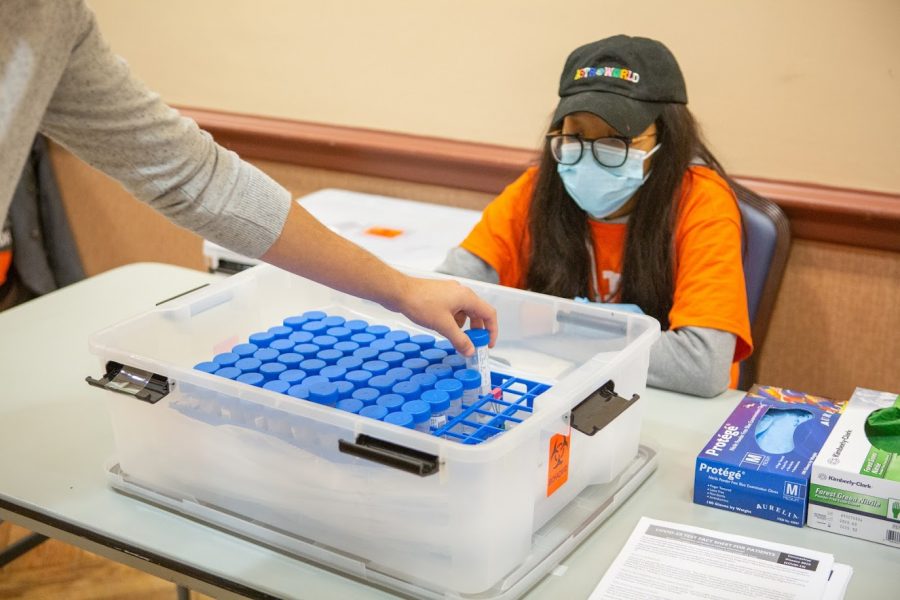Average campus test result sent within 8 hours, SHIELD says
Senior Eric Peronto places his completed COVID-19 test into the receptacle at the Illini Union testing site on Wednesday. The receptacles are then shuttled to the diagnostic laboratory.
Oct 5, 2020
Following weeks of delays reported by students and staff, members of the University’s SHIELD COVID-19 testing team said test turnaround times have dwindled significantly.
Dr. Timothy Fan, a member of the SHIELD team and professor of veterinary clinical medicine, said that the average time that it takes to receive a COVID test result after submitting a sample on campus is now between eight and 8.3 hours.
“When you swipe your i-card, you have a sticker that’s printed and you have an order for a COVID-19 test generated,” Fan said. “The other timestamp that we have is when the final result gets pushed to the electronic medical record system.”
When asked about the previous delays, members of the SHIELD team attribute them to the large influx of COVID tests requested, especially during freshman move-in and directly following Labor Day, when some wait-times exceeded 48 hours.
“Maybe three weeks ago, four weeks ago we were receiving 18,500 samples in a day,” said Fan. “That was just not physically feasible for us to get through in a day.”
Get The Daily Illini in your inbox!
This peaked on Aug. 24 when they received 18,598 tests for processing. According to the University’s COVID dashboard, the lab processed about 1,000 fewer tests that day.
“We were not able to complete (testing) from the day before, before the new samples came in,” Fan said. “It was like a mounding-up snow mound.”
This large influx of tests led the SHIELD team “to become more targeted in how (they) collect saliva samples,” Fan said.
“Students do it twice a week, and faculty and staff only do it once,” said Dr. Leyi Wang, a professor and virologist who oversees the processing of COVID tests at the Veterinary Diagnostic Laboratory. “Since then, things have gotten much better.”
These days, the lab workers aim to process all tests within 24 hours, Fan said.
The new testing guidelines have “really evened out the number of samples we receive on a daily basis to a very manageable 10,000 per day,” Fan said.
“That’s what the lab was originally designed to handle, about 10,000 per day,” he added, down from the University’s pre-semester promise of 20,000 tests per day.
All campus saliva tests are analyzed by staff at the College of Veterinary Medicine’s Diagnostic Laboratory.
Using a testing method developed at the University, the Veterinary Diagnostic Lab is able to test for the presence of COVID-19 in saliva using a process called a real-time Polymerase Chain Reaction, or PCR.
Saliva samples are shuttled hourly from the 17 testing centers across campus to the Veterinary Diagnostic Laboratory in sealed plastic “totes,” the boxes where test samples are placed at each site.
“On a busy day, there could be two or three (totes) an hour,” said Amaris Rodriguez, an employee at the Student Dining and Residential Programs testing center. “There’s a driver that comes here every hour and picks them up.”
Once delivered, the samples are brought into the main receiving room. From there, technicians at the Veterinary Diagnostic Laboratory split them into separate batches for testing.
Wang said each batch of COVID test samples has 380 tubes.
“We number each tube from one to 380 … and we scan the barcode into the computer,” said Wang. “For the number one tube, the barcode is there. This way, we can track the sample.”
The samples are then heated then cooled, in order to deactivate any viruses present in the saliva samples.
“Once they are barcode-scanned, they go directly into hot-water baths for 30 minutes to inactivate the virus,” Fan said. “Then they are removed, and chilled on ice for five to 10 minutes.”
Afterward, lab technicians manually retrieve 100 microliters of saliva from each sample and transfer it into a well plate containing a buffer solution necessary for a PCR test.
This buffer plate is then combined with various reagents in a larger plate, which is then placed into a PCR machine.
“It goes into the PCR machine, and the machine does its job and spits out the results,” Fan said.
Overall, the actual laboratory process to test one batch of samples takes roughly four hours, according to Wang. However, Fan said that this has to be viewed in the context of the number of samples coming in.






